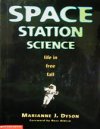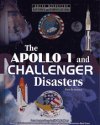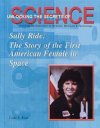Dreams of Floating in Space Additional Information
For information about human space flight, go to http://kids.msfc.nasa.gov/ and http://spaceflight.nasa.gov/ (NASA).
Information about the Columbia Accident Investigation Board and its report can be found at http://spaceflight.nasa.gov/shuttle/ (NASA) and http://www.caib.us/ (Columbia Accident Investigation Board).
Living in Space
http://edspace.nasa.gov/livespace/livespace.html
NASA
What is microgravity?
http://liftoff.msfc.nasa.gov/academy/space/mg.html
NASA Space Academy
Books recommended by SearchIt!Science:
 |
Space Station Science: Life in Free Fall— Marianne Jakmides Dyson
Published by Scholastic, 1999.
“In space, a gallon of water costs as much as a house, you can’t get any TV stations, and opening a window will kill you.” On the other hand, you are in space, and for some people that would make up for just about anything. If you’ve ever wondered what the life of an astronaut might be like, this book is the one for you. It focuses on what life aboard the new International Space Station will be like, but it also explains how astronauts train, the important jobs of mission control, and all the thinking and planning that is needed to get a space station and people into orbit—and keep them there—safely. The biggest obstacle, of course, is that there is no gravity. This changes how people eat, do science experiments and even go to the bathroom. This book shows you some of the creative solutions that astronauts have come up with. This book also suggests lots of do-it-yourself, hands-on activities to show what life in space might be like. |
 |
The Apollo 1 and Challenger Disasters— Gina DeAngelis
Published by Chelsea House, 2001.
“The conquest of space is worth the risk of life,” astronaut Gus Grissom once declared, acknowledging the danger involved in the space program. This book takes a look at two of the American space program’s greatest disasters. First, it delves into the roots of NASA, mentioning the space race and the early search for astronauts. Then, the book discusses the Apollo 1 tragedy, in which Grissom and two other astronauts perished in a fire that took place while the Apollo capsule was undergoing a test on the launch pad. Tracing NASA’s history to the development of the space shuttle, the book provides an account of the 1986 Challenger space shuttle disaster, in which the shuttle exploded just 73 seconds after its launch. More than just a retelling of the dramatic disasters, this book goes into the scrutiny of NASA and the investigations and ramifications that followed the disasters. |
 |
Sally Ride: The Story of the First American Female in Space— Linda R. Wade
Published by Mitchell Lane Publishers, 2003.
Sally Ride was completing her ninth year of college, and she wasn’t sure what she was going to do with all the knowledge she had accumulated– until she picked up the college newspaper one day. She read an announcement that NASA was looking for a new group of astronauts, and with her education in physics, Sally Ride thought she could do the job. Out of over eight thousand applicants, she was one of thirty-five that was chosen for astronaut training, and a few years later, she became the first American woman in space. This biography tells Ride’s story, from her childhood dreams of space to June 18, 1983, when she finally lifted off. Accompanied by black-and-white photos, the text describes what being in space is like and the work Ride did on her mission. A final chapter tells about the work Sally Ride did after her mission, including helping to investigate the Challenger disaster and becoming a professor of physics. |
Power Words
gravity: An invisible force that pulls all objects toward each other. The more mass the objects have and the closer together they are, the stronger the force is. The gravity of earth pulls all objects toward Earth’s center.
zero gravity: A condition in which an object appears to have no weight because it is moving in such a way that it balances out the pull of gravity. Astronauts in orbit around Earth experience zero gravity and float around inside their spacecraft. This happens not because the astronauts no longer have any weight, but because the spacecraft undergoes just enough acceleration as it moves around Earth to counterbalance the pull of gravity. If the spacecraft and its astronauts actually had no weight, they would drift away from Earth into space.
Copyright © 2002, 2003 Houghton-Mifflin Company. All rights reserved. Used with permission.
